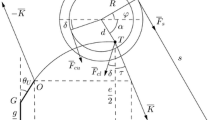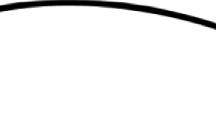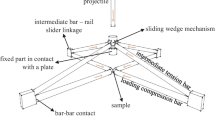Abstract
The static deformation of symmetric bow limbs has been widely studied in the last century. However, asymmetries in shape and length which correspond to a more realistic situation, have not been thoroughly investigated. Here, we report a model for asymmetric bows based on the elastica theory and solved numerically by the Runge–Kutta method. We apply the model to describe the large asymmetric deformation which occurs in the Japanese bow, currently employed in the Japanese martial art of Kyūdō. We compare the model with experimental data acquired from a modern glass-fiber bow and a traditional bamboo bow, different in shape and construction. The model provides accurate results in predicting the deformation and the total energy stored in the bows, as long as the bending stiffness of the limbs is correctly reproduced. The energy is reproduced with an error within 1% and the unbraced and drawn shapes are reproduced with an RMSE of few millimeters compared to the length of \(\sim \,2.2\,\hbox {m}\) of the bows. We investigate the influence of the grip position on the bow strength and shape which is not possible using classic symmetric models. At the end we show the possibility to analyze the bow design and potential failures by computing the bending stress extracted from the solution of the model. This study provides a further development with respect to the existing bow models by including the effect of the limb’s asymmetries in the static performances of the bows. The model for asymmetric limbs can bring important contributions for the design of the bows, reconstruction of ancient bows as well as to study the influence of the asymmetries on the targeting performance in modern competitive archery.











Similar content being viewed by others
References
Hickman CN (1937) The dynamics of a bow and arrow. J Appl Phys 8(6):404
Klopsteg PE (1943) Physics of bows and arrows. Am J Phys 11(4):175
Marlow WC (1981) Bow and arrow dynamics. Am J Phys 49(4):320
Beckhoff K (1964) Der Eibenbogen von Vrees. Die Kunde NF 15:113–125
Kooi B (1981) On the mechanics of the bow and arrow. J Eng Math 15:119
Kooi B (1994) The design of the bow. Proc Kon Ned Akad v Wetensch 97(3):1
Kooi B, Bergman CA (1997) An approach to the study of ancient archery using mathematical modelling. Antiquity 71:124
Hosoya S, Miyaji C, Kobayashi K (1995) Computer simulation of restitution of Japanese bows. J Jpn Soc Sports Ind 5(2):25. https://doi.org/10.5997/sposun.5.2_25
Ohtsuki A, Ohshima S, Yamanaka S, Takeuchi H (2000) Analysis of large deformation of Japanese bows. Proc Comput Mech Conf 2000(13):61. https://doi.org/10.1299/jsmecmd.2000.13.61
Ohtsuki A, Ohshima S, Yamanaka S (2000) Analysis of dynamics of Japanese bows: application of large deflection theory. In: The proceedings of joint symposium: symposium on sports engineering, symposium on human dynamics, vol 130. https://doi.org/10.1299/jsmesports.2000.0_130
Ohshima S, Ohtsuki A, Ooya H (2003) Dynamical analysis of Japanese Bow by using of the segment model. In: The Proceedings of joint symposium: symposium on sports engineering, symposium on human dynamics, vol 243. https://doi.org/10.1299/jsmesports.2003.0_243
Ohtsuki A, Ohshima S (2017) Analysis of nonlinear deformations in Japanese bows (application of elastica theory). Trans Jpn Soc Spring Eng 2017(62):49. https://doi.org/10.5346/trbane.2017.49
Zanevskyy I (2012) Compound archery bow asymmetry in the vertical plane. Sports Eng 15(3):167
Onuma H, DeProspero D, DeProspero J (1993) Kyudo: the essence and practice of Japanese archery. Kodansha International, Tokyo
Mori T, Sato A, Kurosu K, Matsuo M, Yamada S (2010) Kyūgu no zatsugaku jiten. SJ budo (Sukījānaru). https://books.google.co.jp/books?id=IpLFbwAACAAJ
ANKF (1994) Kyudo manual: volume 1, principles of shooting. A.N.K.F. Publ, Tokyo
IKF. https://www.ikyf.org/. Accessed 2019/07/01
Bisshopp K, Drucker D (1945) Large deflection of cantilever beams. Q Appl Math 3(3):272
Frisch-Fay R (1962) Flexible bars. Butterworths, London
Eaton JW, Bateman D, Hauberg S, Wehbring R (2016) GNU Octave version 4.2.0 manual: a high-level interactive language for numerical computations. http://www.gnu.org/software/octave/doc/interpreter
Tiermas M (2017) The limb deformation of the compound bow. Meccanica 52(6):1475
Broyden CG (1965) A class of methods for solving nonlinear simultaneous equations. Math Comput 19(92):577
Hearn E (1997) Mechanics of materials 1: an introduction to the mechanics of elastic and plastic deformation solids and structural materials. Butterworth-Heine-mann, London
Young WC, Budynas RG, Sadegh AM et al (2002) Roark’s formulas for stress and strain, vol 7. McGraw-Hill, New York
Allen HG (1969) Analysis and design of structural sandwich panels. The commonwealth and international library: structures and solid body mechanics division. Pergamon, London
Gibson LJ, Ashby MF (1999) Cellular solids: structure and properties. Cambridge University Press, Cambridge
http://www.koyama-kyugu.com/. Accessed 2019/07/01
Ross RJ et al (2010) USDA Forest Service, Forest Products Laboratory, General Technical Report FPL-GTR-190, 509, vol 190, p 1
Suetsugu M, Tsuji M, Nishioka M (2010) Shear sliding stress at the interface of members of a Japanese-style bow. J Jpn Soc Sports Ind 20(2):149. https://doi.org/10.5997/sposun.20.149
Urakami S (1935) Kyudo oyobi kyudoshi. Budō zenshū (Heibonsha). https://books.google.co.jp/books?id=bkg-AQAAIAAJ
Urakami S (1996) Tenouchi (momiji gasane), hanare, yumi no mikata to atsukaikata (Yūgisha). https://books.google.co.jp/books?id=h7VfXwAACAAJ
http://www.gordoncomposites.com/. Accessed 2019/07/01
Hamada H (2017) Materials technology in Kyoto bow. Jpn J Soc Mater Sci 66(11):811. https://doi.org/10.2472/jsms.66.811
Prospect (1997) The wood database. Version 2.1. Oxford Forestry Institute, London
Anonymous (1974) cc. Forest Research and Training Circle, Forest Department, Burma. 121 pp
Yamamoto H (2002) Interdisciplinary research of evolution and degeneration of arms: a volume on bow and arrows. Int Res Cent Jpn Stud 27:141–151. https://doi.org/10.15055/00005338
Hickman CN (1947) Archery: the technical side. National Field Archery Association, New York
Joji O, Megumi N, Masaru A, Shinichi K (2002) pp 108–111. http://www.oita-ri.jp/siryou/kenkyu-report/2002-2
Obataya E, Kitin P, Yamauchi H (2007) Bending characteristics of bamboo (Phyllostachys pubescens) with respect to its fiber–foam composite structure. Wood Sci Technol 41(5):385
Janssen JJ (2012) Mechanical properties of bamboo, vol 37. Springer, Berlin
Blazynski TZ (1983) Applied elasto-plasticity of solids. Macmillan International Higher Education, New York
Hosoya S, Kobayashi K, Miyaji T (1989) Abstracts of Japan society of physical education. Health Sport Sci Conf 40A:381. https://doi.org/10.20693/jspeconf.40A.0_381
Hosoya S (2002) Interdisciplinary research of evolution and degeneration of arms: a volume on bow and arrows. Int Res Jpn Stud 27:193–206. https://doi.org/10.15055/00005346
Kooi BW (1996) Functioning of ears and set-back at grip of Asiatic bows. J Soc Archer-Antiqu 39:73
Junkmanns J (2013) Pfeil und Bogen: von der Altsteinzeit bis zum Mittelalter. Verlag Angelika Hörnig, London
Bjurhager I, Gamstedt EK, Keunecke D, Niemz P, Berglund LA (2013) Mechanical performance of yew (Taxus baccata L.) from a longbow perspective. Holzforschung 67(7):763
Gere DJ, Goodno BJ (2018) Mechanics of materials, 9th edn. Cengage Learning, New York
Hurst MK (2017) Prestressed concrete design. CRC Press, Boca Raton
Acknowledgements
The authors would like to thank all the people who contributed or were involved in the realization of this manuscript. We thank Tsuchiura Kyūdō Shop for providing bow samples to analyze and Dr. Eiichi Obataya for fruitful discussions on lumber and bamboo. We thank Hunter Gott for proofreading the English text of the manuscript.
Author information
Authors and Affiliations
Corresponding author
Ethics declarations
Conflict of interest
The authors declare that they have no conflict of interest.
Additional information
Publisher's Note
Springer Nature remains neutral with regard to jurisdictional claims in published maps and institutional affiliations.
Appendices
Appendix 1: Contribution of the limb’s components to the bending stiffness
The final strength of the bows is directly related to the bending stiffness. By using Eq. (28) we calculated the contribution of the limb’s components to W(s), excluding the string stopper close the limb tip, as shown in Fig. 12. The calculated average percentage contributions \(W^{\%}\) are the following; albeit rather simple calculation, we can get an insight of the role played by the layers of the limbs. In case of the GF bow, the upper fiberglass sheet accounts for \(W^{\%}_{f1} \simeq 36\%\), the lower sheet for \(W^{\%}_{f2} \simeq 35\%\) and the wood core for \(W^{\%}_{w} = 29\%\). In the B bow, uchidake, todake, higo and sobagi contribute for \(W^{\%}_{u} \simeq 49.5\%, W^{\%}_{t} \simeq 46\%, W^{\%}_{h} \simeq 3.3\%\) and \(W^{\%}_{s} \simeq 1.2\%\) respectively. In both the bows, the major contribution comes from the external layers. In Fig. 12a, the trend of the contributions for the GF bow is linked to the thickness of the wood core which decreases from the grip to the limb tips, whereas the thickness of the fiberglass is kept constant at 1 mm. For the B bow in Fig. 12b, the external bamboo layers are thicker (4-5 mm) with their thickness constant along the limbs and since they are the furthest parts from the centroid of the cross-section, contribute together more than 90%. Contrary to what is traditionally believed in Japanese bow manufacturing, according to these results the main function of the core would be to add thickness for increasing the inertia of the outer parts rather than giving a direct contribution to the bow strength. The function of higo, usually cut from the low-density internal part of bamboo culm responsible for absorbing compression, could be the damping of bow vibrations.
Percentage contribution of the cross-section parts to W(s). a GF bow: wood core \(W^{\%}_{w}\), belly (back) side fiberglass sheets \(W^{\%}_{f1(2)}\). b B bow: uchidake (belly) \(W^{\%}_{u}\), todake (back) \(W^{\%}_{t}\), higo core \(W^{\%}_{h}\) and lateral sobagi strips \(W^{\%}_{s}\) (Color figure online)
A confirmation of the percentage contributions of W(s) can be done by using the simple three-layer structure of the sandwich beam theory [25, 26]. By using Eq. (28), the stiffness of a rectangular sandwich limb of width w, with a core of thickness c and two external skins of thickness t, can be written as
where \(W_{c}\) and \(W_{f}\) represent the stiffness of the core and faces respectively. \(E_{c}\) and \(E_{f}\) are the Young moduli of the core and faces. To derive Eq. (35), we used the second-moment of area of a rectangular element about its centroid written as
where \(d = t, c\) is the thickness of the single layers. Note that in Eq. (35), \(W_{sw}\) varies as the cube of the thicknesses (\(c^{3}, t^{3}\)) by Eq. (36) and it varies as the square of the distance of the outer layers from the centroid \((c+t)\)/2 by Eq. (28). We now define normalized stiffness terms as \({\overline{W}} = 12 \cdot W/(Ewc^{3})\). If we take three layers of the same thickness \(t = c\) and material \(E_{c} = E_{f} = E\), we get for the core and the skins \({\overline{W}}_{c} = 1\) and \({\overline{W}}_{f} = 26\). This means a contribution of 3.7% for the core and 96.3% for the external layers; this case resembles well the B bow. Similarly to the case of the GF bow, if the outer skins have \(E_{c} = E\) and \(E_{f} = 4E\) and \(t = c/10\), it follows that \({\overline{W}}_{c} = 1\) and \({\overline{W}}_{f} = 364/125 \sim 2.912\). This means a contribution of 25.6% for the core and 74.4% for the faces. To conclude, regardless the yield stress of materials or strength-to-weight ratio problems, the thickness of the limb and stiff parts placed externally are the main contributors to the stiffness; light and less stiff parts instead should be used as the core of the limb.
Appendix 2: Traditional rules for bow manufacturing
In this section, we want to briefly comment on using the asymmetric model, the design of the bamboo bow according to traditional manufacturing rules. Traditionally, for a fixed bow length L and construction rules of a bow-maker, the strength of bamboo bows was evaluated by measuring the maximum thickness of the limb above the grip, which is located in correspondence of a bamboo node of the belly side. This operation was called “Bu Ai”, from the Japanese measurement units (1 bu = 3 mm) [31] and it is used even nowadays as reference quantity during the bow construction. As expected by Eq. (32) of the linear beam theory, the greater changes in the final strength of the bow are due to thickness variations of the limbs. This has been widely discussed e.g. in Refs. [5, 21, 45]. Looking at the second-moment of inertia of a beam with rectangular cross-section shown in Eq. (36), in the same way the stiffness of the bow limb depends linearly on the width and varies as the cube of the thickness. Hence, small variations of the thickness can produce large variations in the bending stiffness. The same dependence exists for the trapezoidal cross-section [24]. For this reason, it would be reasonable to judge the strength of the bamboo bow with the Bu Ai criterion, according to the grip thickness.
Bow force \(F_{b}\) calculated at \(b = 0.90\) m, \(b_{f} = 0.145 \,\hbox {m}\) for a bow with length \(L\simeq 2.25\) m and \(c_{D}\simeq 0.38\) at different initial curvatures u and grip thicknesses \(t_{G}\), taking \(E_{b} = 16 \,\hbox {GPa}\). The arrow indicates the curves for increasing u, from the bottom: \(u = 9 \,\hbox {cm}\), 11.8 cm, 14 cm, 17.4 cm, 19.3 cm, 22 cm. The inset shows the rough cross-section created for the calculations
To analyze the dependence of the bow strength on the limb thickness, we construct a fictitious bending stiffness for the limbs based on the following construction rules. As shown in the inset of Fig. 13, for simplicity we choose the shape of a rough bamboo bow which is not tapered in a trapezoidal cross-section yet. The thicknesses \(t_{T}\) and \(t_{U}\) of the external (\(\textit{todake}\)) and internal (\(\textit{uchidake}\)) bamboo sheets are usually fixed around 4 mm and 5 mm and cut from a bamboo culm with a radius of 4–5 cm or greater; for the calculation we set a radius of \(R = 4 \,\hbox {cm}\). Different bow strengths can be obtained by changing the thickness of the core \(t_{C}\) constituted by bamboo strips (\({higo}\)) with a total width of \(w_{C} = 16 \,\hbox {mm}\) and lateral wood strips (\({sobagi}\)). Excluding the rigid string stopper of the limb tip, we reduce \(t_{C}\) linearly from the grip to the limb tip about 3 mm. The maximum width of the finished bow at the grip is usually fixed around \(w_{G}= 27 \,\hbox {mm}\) and decreases 3 mm to the tip.
However, a second variable to consider is the initial curvature of the bow, which has been previously shown as a determinant factor for its static performance [5]. In particular, the curvature of the bamboo bow is not strictly fixed since it can vary according to environmental conditions, so we introduced it as a second variable. In Japanese archery, the information about the curvature or \(\textit{urazori}\) is evaluated as the height of the recurve of the unbraced bow. Similarly, here we calculate u as the difference between the x-coordinates of the grip (belly side) and limb tips when the tips of the upper and lower limbs have the same final x-coordinates. Figure 13 shows the calculated strength of the bow at full draw (\(b = 0.90 \,\hbox {m}\)) for increasing grip thickness \(t_{G}\) and curvature u. The Young moduli of the materials used in the B bow was used in the calculations. As input of the initial curvatures we used real shapes of different unbraced bows, ensuring with the model that the characteristic shape of the bows at full draw was preserved. Now we fit the simulated curves with a power function \(A(u)\cdot t_{G}^{B(u)}\), and we derive the equation for estimating the bow force \(F_{b}\) as
where u and \(t_{G}\) are expressed in cm and the force is calculated in kgf. As shown in Fig. 13, in a range of \(t_{G} = 1.2-1.8\) cm, \(F_{b}\) changes in a range of \(\sim\) 5–27 kgf. From Eq. (37) we can note that with respect to the linear beam theory, \(F_{b}\) varies slightly more than the cube of the thickness. For a fixed \(t_{G}\), the force increases linearly with the curvature in a range of \(u = 9-22\) cm. However, due the high variability of bamboo and its elasto-plastic behavior, these calculations must be taken just as a qualitative investigation and precise quantitative calculations need to be performed according to the characteristics of the bamboo (e.g. aging, density, treatment) employed in the bow.
Rights and permissions
About this article
Cite this article
Mariani, G., Matsuo, M. The static deformation of the asymmetric Japanese bow: modelling bow asymmetries with the elastica theory. Meccanica 55, 1733–1752 (2020). https://doi.org/10.1007/s11012-020-01213-2
Received:
Accepted:
Published:
Issue Date:
DOI: https://doi.org/10.1007/s11012-020-01213-2






